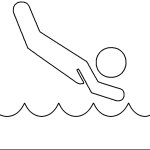Traumatic Brain Injury
Overview
Traumatic brain injury (TBI) is
an acquired injury to the brain caused by an external physical force, resulting in total or partial functional disability or psychosocial impairment, or both, that adversely affects a child’s educational performance. Traumatic brain injury applies to open or closed head injuries resulting in impairments in one or more areas, such as cognition; language; memory; attention; reasoning; abstract thinking; judgment; problem-solving; sensory, perceptual, and motor abilities; psychosocial behavior; physical functions; information processing; and speech. Traumatic brain injury does not apply to congenital or degenerative brain injuries, or to brain injuries induced by birth trauma. (IDEA)
One half of one percent of students qualifying for services under the IDEA have a TBI designation (National Center for Education Statistics, 2022).
The traumatic brain injury (TBI) category is not a very prevalent type of disability among school-aged children. Students who sustain a TBI can return to school in a short or long amount of time, depending on the severity of the injury. The range of injury can include cognitive, physical, and psychosocial challenges (Bowen, 2008).
Strengths
Students with traumatic brain injury have many strengths. While areas of the brain that have been injured may affect different aspects of a student’s ability to function in school, students still may retain many of the strengths they had before the injury, including areas of cognitive ability, physical ability, and socialization. Educators can support students by finding areas of strengths not affected by the trauma and focus on those areas while continuing to strengthen the areas that have been affected (Wehman, & Targett, 2010).
Needs
Students with the TBI disability type may require additional support with cognitive processes, communication, mobility, self-care, and emotional and behavioral regulation. Depending on the severity of the injury, any of these issues may significantly affect educational performance (Brainline).
 Reflection
Reflection
Supporting Students with a Traumatic Brain Injury
The section below explains some strategies for supporting students experiencing a traumatic brain injury. Based on what you have read so far, what strategies do you think might be useful for supporting students experiencing a traumatic brain injury?
Common Teaching Strategies
Brainline offers the following ways to help promote learning among students with traumatic brain injury:
- Use a direct statement telling the student to start (rather than stop) a behavior.
- Look directly at the student as you give the request, move close, and use a soft, calm voice.; speak clearly, slowly and concisely—do not shout.
- Limit requests to only two or three at a time and give requests that the student is capable of following.
- Allow enough time for the student to follow through.
- Recognize their effort with verbal praise and encouragement. (Classroom Interventions for Students with Traumatic Brain Injuries)
 Deeper Dive
Deeper Dive
Traumatic Brain Injury
For more information about traumatic brain injury, review the following resources:
References
Bowen, J. M., (2008). Classroom interventions for students with traumatic brain injuries. Brainline: All about brain injury and PTSD. Retrieved from https://www.brainline.org/article/classroom-interventions-students-traumatic-brain-injuries
National Center for Education Statistics. (2022). Students With Disabilities. Condition of Education. U.S. Department of Education, Institute of Education Sciences.
U.S. Department of Education. (2018). Sec. 300.8 Child with a disability. Retrieved from https://sites.ed.gov/idea/regs/b/a/300.8
Wehman, P. & Targett, P. (2010). Returning to school after traumatic brain injury. Model Systems Knowledge Translation Center. Retrieved from https://msktc.org/tbi/factsheets/returning-school-after-traumatic-brain-injury#fsmenu1
means an acquired injury to the brain caused by an external physical force, resulting in total or partial functional disability or psychosocial impairment, or both, that adversely affects a child’s educational performance. Traumatic brain injury applies to open or closed head injuries resulting in impairments in one or more areas, such as cognition; language; memory; attention; reasoning; abstract thinking; judgment; problem-solving; sensory, perceptual, and motor abilities; psychosocial behavior; physical functions; information processing; and speech
